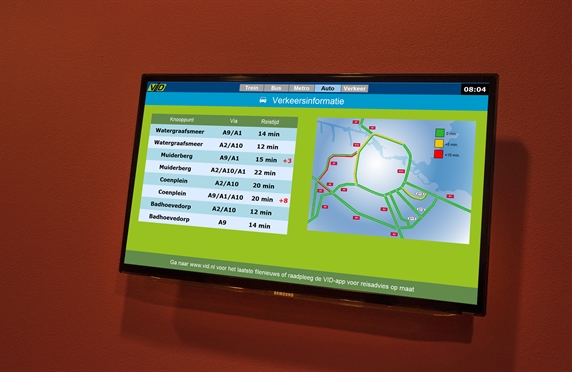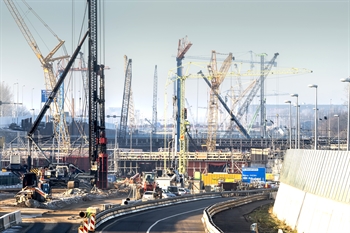Case study Narrowcasting screens deployed at Schiphol, Amsterdam, Almere (SAA)
At the entrances, exits and lobbies of busy locations in the SAA project area (hospitals, event locations, large shops and major companies), Rijkswaterstaat has installed travel information screens (also known as narrowcasting screens).
On these narrowcasting screens, the following location-specific information is provided and displayed by market partner Traffic Information Service (VID):
- the driving times to major motorway junctions from the location in question
- graphic information about traffic jams that indicates how much delay there is on which roads
- all major current and planned road works within the SAA region
- the departure times for nearby public transport services
- the weather forecast including rainfall radar
Background and aim
The road network between Schiphol, Amsterdam and Almere is being expanded. To improve the flow on SAA routes, the narrowcasting screens help travellers at locations in the SAA region in an easily accessible way to make smart choices. The travel information ensures that they are able to choose their time of departure and route as efficiently as possible. In some cases, the information may also lead to a smart choice for a different mode of transport. The aim was also to generate as much support as possible for the SAA works being carried out by various environmental parties by offering them these narrowcasting screens with information.
Scope and effect
Narrowcasting screens have been hung at 15 locations. The number of people who looked at the narrowcasting screens and then adapted their journey is difficult to measure and therefore not known. However, an attempt was made to measure the effect at one location (Academic Medical Centre in Amsterdam) by means of a user survey. This yielded the following results:
| Percentage | Viewing habits |
|---|---|
| 22% | never look |
| 32% | rarely look |
| 30% | sometimes look |
| 11% | mostly look |
| 6% | always look |
Does the information displayed on the narrowcasting screens affect the traveller's travel behaviour?
| Travel behaviour | No | Sometimes | Often |
|---|---|---|---|
| The traveller chooses a different mode of transport | 85% | 14% | 1% |
| The traveller chooses a different route | 69% | 29% | 2% |
| The traveller chooses a different time | 74% | 25% | 1% |
Side effects of the screens are the positive reactions from companies and locations where the screens are installed. This has contributed to creating a base of support for the SAA programme.
Points for attention
- Coordination with companies: good coordination with the locations is necessary to ensure that their wishes are taken into account in developing the measure. This can create a base of support at the locations where the narrowcasting screens are to be hung.
- Efforts made by the company: it must be relatively easy to hang up the narrowcasting screens at the various locations.
- Accuracy of the information: it is important to make proper
agreements with the market parties (data providers) on the
information displayed. And, of course, the content must always
be correct. - Reach: narrowcasting screens are best used by companies and crowd-pulling locations with a large reach. The threshold chosen in the SAA project is companies with at least 500 employees.
- Collaboration: for the implementation of SAA, Rijkswaterstaat provided the screens, service provider VID supplied real-time travel information on the screens and the locations provided a good place for the screen, the power and an internet connection.
- Start on time: the collaboration between the various parties involved, getting the travel information right and getting the screens at the locations up and running are time-consuming processes. Think, for example, about the internal procurement process and coordination within the relevant locations.

Can the measure be deployed more broadly?
Narrowcasting screens can be utilised for projects by Rijkswaterstaat and other authorities. The narrowcasting screens in this example were installed around 2012-2013 and nowadays they are actually a little outdated. Nowadays it would probably be more appropriate to use smartphone technology. Nevertheless, eye-catching screens with good up-to-date travel information, at large companies or at crowd-pulling locations around a project that causes annoyance, can certainly still have added value.
If only to create awareness in the traveller and to increase support at the locations.

